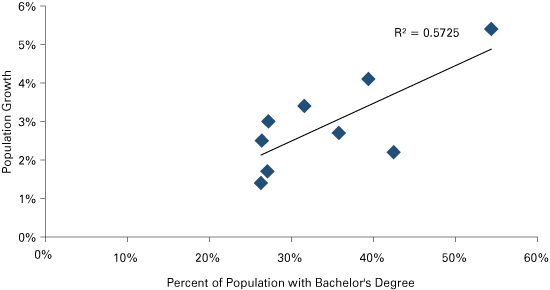Columbus Forecast 2014
Assistant Professor of Finance, IU Division of Business, Indiana University–Purdue University Columbus
Organizations around Columbus invested over $21 million of long term capital per year from 2005 through 2012, beautifying the downtown area and creating new, modern spaces for business and leisure.1 Why? The reasoning lies in attracting and retaining talented people and to secure more well-paying jobs. This strategy has been working. One question remains: given considerable uncertainty arising from soft global markets conflated with national political instability, will this strategy continue to work?
From 2010–2012, Bartholomew County realized the state’s fourth highest population growth, a change of 3 percent.2 Interestingly, for the state’s nine most highly educated counties (the top 10 percent), being educated is correlated to attracting more people (see Figure 1).
Figure 1: Population Growth Among Indiana’s Most Highly Educated Counties, 2010 to 2012

Note: The counties with the highest percent of adults holding a bachelor’s degree in order include Hamilton, Monroe, Boone, Tippecanoe, Hendricks, Bartholomew, Marion, Johnson and Allen.
Source: STATS Indiana
With respect to talent as measured by level of educational attainment, Bartholomew County ranks near the median among counties in the United States on the whole—and Indiana ranks 44th among the states. Even so, Bartholomew County ranks sixth among Indiana’s 92 counties in the level of educational attainment, with 27.2 percent of its adults having earned a bachelor’s degree or higher, yielding a strong and growing highly educated workforce suitable for attracting jobs in advanced, high-tech manufacturing.
Coincident with strong population growth and highly educated people, Bartholomew County has experienced impressive recent net job creation, namely in the manufacturing sector, which captures 37.3 percent of all jobs in the county. For instance, in August of 2013, Columbus added 1,000 jobs, a 2 percent increase over July. In fact, Columbus, Indiana ranked fifth nationally among metropolitan statistical areas (MSAs) over the period, and 22nd nationally over the past year with a total of 1,800 new jobs created.3 It is important to note that Columbus continues to see average per capita income rise due to high paying jobs being created. Per capita income in Columbus rose from $37,023 in 2010 to $39,645 in 2011.4 This 7.1 percent rise in per capita income bested every city in our control group aside from North Vernon, which experienced a rise of 7.7 percent to $31,435 as of 2011 (see Table 1).
Table 1: Annual Per Capita Personal Income for Select Indiana Cities, 2006 to 2011
| 2006 | 2007 | 2008 | 2009 | 2010 | 2011 | Income Growth Rate 2010–2011 | |
|---|---|---|---|---|---|---|---|
| North Vernon | $26,654 | $27,958 | $29,353 | $28,728 | $29,200 | $31,435 | 7.7% |
| Columbus | $35,520 | $36,504 | $38,377 | $35,579 | $37,023 | $39,645 | 7.1% |
| Kokomo | $31,592 | $33,127 | $32,988 | $30,962 | $31,087 | $33,126 | 6.6% |
| Greensburg | $29,664 | $30,930 | $33,103 | $31,737 | $32,592 | $34,354 | 5.4% |
| Seymour | $29,655 | $30,931 | $32,632 | $31,477 | $31,386 | $32,941 | 5.0% |
| Evansville | $35,095 | $35,499 | $37,757 | $35,819 | $37,290 | $39,021 | 4.6% |
| Bloomington | $27,496 | $28,607 | $30,149 | $29,549 | $29,719 | $30,915 | 4.0% |
| Anderson | $29,230 | $29,899 | $29,698 | $28,795 | $29,322 | $30,421 | 3.7% |
| Indiana | $33,087 | $34,016 | $34,966 | $33,679 | $34,386 | $36,342 | 5.7% |
| United States | $38,127 | $39,804 | $40,873 | $39,357 | $40,163 | $42,298 | 5.3% |
Source: Bureau of Economic Analysis
As of August 2013, there were 51,300 jobs positioned within the Columbus MSA. At the same time, the labor force consisted of 42,920 people, which implies that Columbus currently generates 8,380 jobs for residents of neighboring communities (see Table 2).
Table 2: Employment for Metros and Micros, 2006 to 2013
| 2006 | 2007 | 2008 | 2009 | 2010 | 2011 | 2012 | August 2013 | |
|---|---|---|---|---|---|---|---|---|
| Evansville | 179,300 | 178,900 | 176,400 | 169,600 | 173,100 | 175,700 | 176,300 | 177,200 |
| Bloomington | 81,200 | 79,800 | 82,500 | 77,800 | 76,200 | 76,900 | 80,400 | 76,400 |
| Columbus | 44,600 | 45,800 | 45,900 | 41,100 | 42,000 | 46,300 | 49,600 | 51,300 |
| Kokomo | 47,900 | 46,600 | 44,700 | 39,700 | 40,300 | 41,200 | 42,600 | 43,600 |
| Anderson | 42,200 | 41,100 | 42,100 | 40,900 | 40,300 | 40,300 | 41,100 | 41,900 |
| Seymour | 21,485 | 21,579 | 20,987 | 18,744 | 19,320 | 19,651 | 19,460 | 20,523 |
| North Vernon | 13,137 | 13,162 | 12,933 | 11,762 | 12,023 | 12,017 | 12,081 | 12,498 |
| Greensburg | 12,268 | 11,940 | 12,132 | 11,149 | 11,102 | 11,349 | 11,188 | 12,198 |
| Indiana | 2,958,200 | 2,984,700 | 2,961,600 | 2,754,700 | 2,805,100 | 2,834,900 | 2,917,000 | 2,962,800 |
| United States | 136,149,000 | 137,534,000 | 136,697,000 | 129,786,000 | 129,728,000 | 131,457,000 | 133,753,000 | 135,961,000 |
Notes: Shaded areas are micros. Data are not seasonally adjusted.
Source: Bureau of Labor Statistics
The unemployment rate in Columbus stood favorably at 5.5 percent as of August 2013, compared to 7.5 percent for Indiana and 7.3 percent for the United States (using not-seasonally adjusted data). Surrounding areas of Seymour, Greensburg and North Vernon sustained unemployment rates of 6 percent, 6.9 percent and 8.3 percent, respectively. Notably, while these neighboring communities of Seymour, Greensburg, and North Vernon have experienced higher rates of unemployment, each of them has also added jobs since 2012, and in concert their employment bases have risen collectively by 2,490 people, again led by opportunities in automotive manufacturing.
Considering that the majority of new jobs in the Columbus MSA have been generated from economic activity in the manufacturing sector, it is of interest to note that the heavily automotive towns of Anderson and Kokomo have not fared as well as Columbus. For instance, the city of Kokomo employed 43,600 as of August 2013, an increase of 2,400 jobs since 2011. During the same period, Columbus gained 5,000 jobs. Kokomo also provided an employment base of 43,302 as of August 2013, exporting only 298 jobs to neighboring communities. Moreover, Kokomo also sustained an 8.1 percent unemployment rate. For Anderson, the news is even less encouraging. Anderson had a labor force of 61,569 and an employment base of 41,900 as of August 2013. With an unemployment rate of 8.6 percent, this implies that over 14,000 of Anderson’s citizens find work in communities neighboring Anderson.
On the housing front, low mortgage rates and thousands of good new jobs have spurred a home buying spree we have not seen in Columbus since before the Great Recession. As of August 2013, Bartholomew County had processed 170 housing permits—a pace of 255 total for the year if things continue, higher than any year since 2007 (257 permits filed). Additionally, the average home sale price rose for the fourth consecutive year in the Columbus MSA, up by nearly 3.7 percent in 2013. The number of homes sold in Columbus in 2013 is on track to surpass 900, a number also unseen since 2007.
Outlook
The Columbus economic outlook for 2014 is neutral to slightly favorable. On the positive side, things have been going very well locally. The 4th Street community area is now complete, Columbus continues to maintain mutually cooperative leadership in many organizations throughout the city, and the downtown redevelopment effort has been accompanied by an assortment of festivals, sports, arts, architecture, tourist activities, and even a mid-major, full-length marathon. Indiana’s leading index is at a six-year high (101.48), local building permits are on track for a record year and national stock market indices continue to show strength with impressive market capitalizations.
On the negative side: Cummins just lowered its forecast for the fourth quarter of 2013 and 2014 on weaker than expected demand, and despite near-record revenue levels, Cummins expects its sales in 2013 to end below 2012 levels. Cummins has also forecasted 2014 sales to be flat, with many markets sustaining slow growth or weak demand. Also, the national debate regarding the debt ceiling and future discussions on tax policy creates an air of uncertainty which has a chilling effect on economic growth. Congressional gridlock and government shutdowns are merely a sideshow versus the real economic damage that could be inflicted on capital intensive businesses if tax policies and Federal Reserve policies are not handled with clarity and care.
The Columbus economy is tied to the interactions of external and internal forces. To the former, growth in the manufacturing sector on the whole, relevant markets around the globe and the health of the automotive and transportation industries will continue to fuel demand for products and services that Columbus is well-positioned to provide. To the latter, a continued focus on local redevelopment and the cooperative efforts seen among leaders around the city will likely continue to result in the creation of intangible, unique qualities yielding economic opportunities. With a little help from constituents in Washington, D.C. and around the world, Columbus should be able to sustain a pace for modest growth in 2014.
Notes
- City of Columbus, Redevelopment Office, www.columbus.in.gov/redevelopment/economic-impacts-of-redevelopment/, accessed October 30, 2013.
- STATS Indiana, www.stats.indiana.edu/uspr/a/us_profile_frame.html, accessed October 15, 2013.
- Department of Numbers, www.deptofnumbers.com/employment/metros/, accessed October 31, 2013.
- United States Bureau of Economic Analysis, www.bea.gov/, accessed October 15, 2013.
Also in this Issue…
- International Outlook for 2014
- U.S. Outlook for 2014
- Financial Outlook for 2014
- Housing Outlook for 2014
- Indiana's Outlook for 2014
- Indiana's Agricultural Outlook for 2014
- Seeking Escape Velocity—Job, Income and Productivity Forecasts
- Anderson Forecast 2014
- Bloomington Forecast 2014
- Columbus Forecast 2014
- Evansville Forecast 2014
- Fort Wayne Forecast 2014
- Gary Forecast 2014
- Indianapolis-Carmel Forecast 2014
- Lafayette Forecast 2014
- Louisville Forecast 2014
- Muncie Forecast 2014
- Richmond Forecast 2014
- South Bend and Elkhart Forecast 2014
- Terre Haute Forecast 2014




